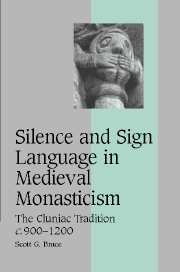Book contents
- Frontmatter
- Contents
- List of tables
- Acknowledgments
- List of abbreviations
- Map
- INTRODUCTION: THE DORMANT LANGUAGE
- 1 UTTERING NO HUMAN SOUND
- 2 THE TRAINING OF THE HAND
- 3 A SILENT COMMERCE OF SIGNS
- 4 TRANSMISSION AND ADAPTATION
- 5 CONTINUITY AND CRITICISM
- CONCLUSION
- Appendix A: The Cluniac sign lexicon
- Bibliography
- Index
- Cambridge Studies in Medieval Life and Thought Fourth Series
CONCLUSION
Published online by Cambridge University Press: 16 July 2009
- Frontmatter
- Contents
- List of tables
- Acknowledgments
- List of abbreviations
- Map
- INTRODUCTION: THE DORMANT LANGUAGE
- 1 UTTERING NO HUMAN SOUND
- 2 THE TRAINING OF THE HAND
- 3 A SILENT COMMERCE OF SIGNS
- 4 TRANSMISSION AND ADAPTATION
- 5 CONTINUITY AND CRITICISM
- CONCLUSION
- Appendix A: The Cluniac sign lexicon
- Bibliography
- Index
- Cambridge Studies in Medieval Life and Thought Fourth Series
Summary
As this study has shown, the monks of tenth-century Cluny developed an elaborate system of meaning-specific hand signs as a means to achieve an ideal of angelic conduct that included the cultivation of an all-embracing silence. The inhabitants of early medieval abbeys generally esteemed the abnegation of the will to speak as a virtuous practice that protected monks from the sins of slander and murmuring. Unlike their contemporaries, however, the Cluniacs also freighted this custom with positive moral and eschatological associations. With their thoughts fixed firmly on the life to come, they strove to live in consonance with their angelic counterparts in heaven. By embracing strict regulations against idle conversation, the monks of Cluny set themselves apart in the Christian tradition in their unrivaled effort to actualize within the walls of their monastery the eternal silence enjoyed by the elect at the end of time.
The development of monastic sign language was a corollary to the rigorous prohibitions against speaking embraced at Cluny. The cultivation of silence raised practical difficulties in large religious houses, where the responsibilities of communal life required that individuals communicate with one another on a regular basis. The use of signs in place of speech was not unknown in late antique and early medieval monasticism, but the silent language of the Cluniacs was unprecedented in its range of vocabulary and precision of expression, causing some contemporaries to complain that this custom was incongruent with received tradition.
- Type
- Chapter
- Information
- Silence and Sign Language in Medieval MonasticismThe Cluniac Tradition, c.900–1200, pp. 171 - 176Publisher: Cambridge University PressPrint publication year: 2007

